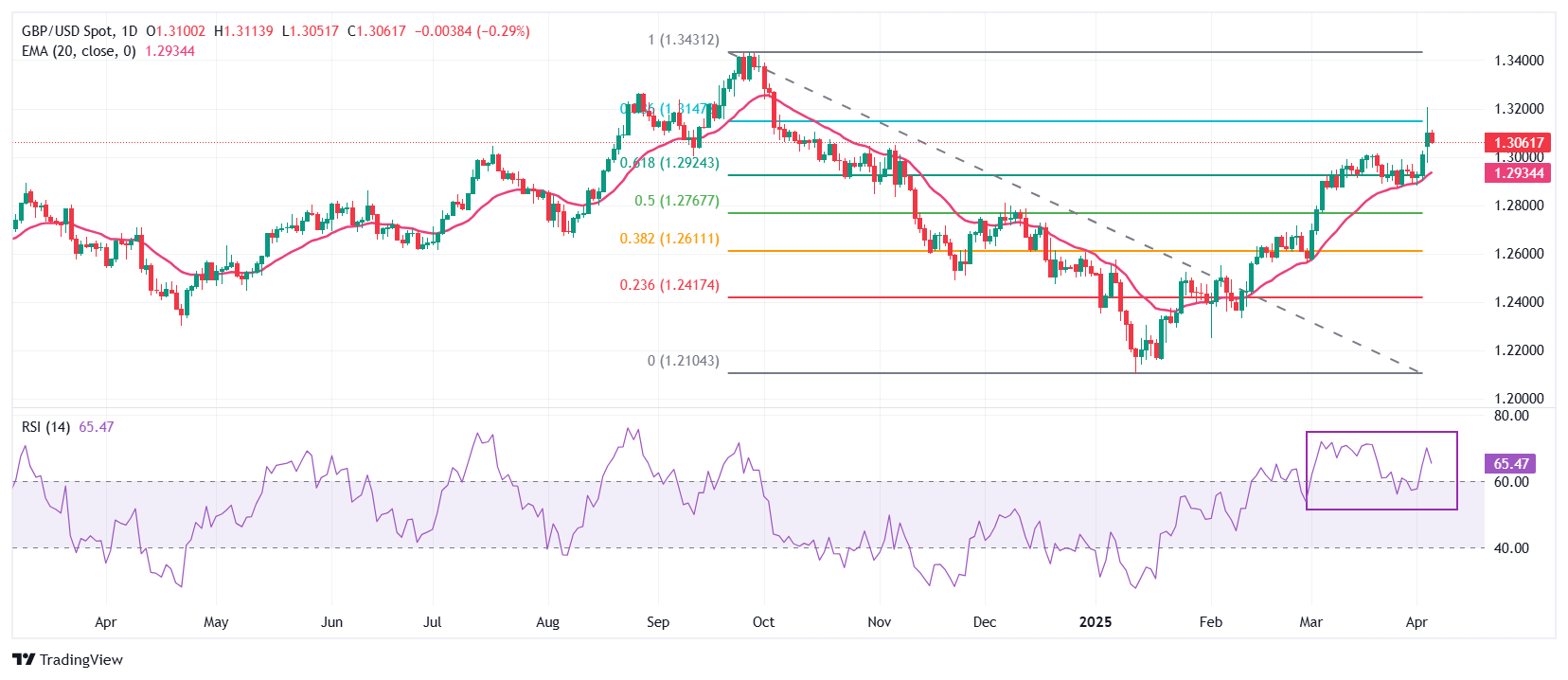Pound Sterling Clings To Gains Against US Dollar As US Economy Faces Shockwaves
- The Pound Sterling trades firmly above 1.3000 against the US Dollar as Trump’s reciprocal tariffs have dampened the US economic outlook.
- Investors await the US NFP data for March and Fed Powell’s speech.
- The UK economy appears to be in a better position among all US trading partners after the release of Trump’s detailed reciprocal tariff plan.
The Pound Sterling (GBP) holds onto Thursday’s gains above 1.3000 against the US Dollar (USD) during European trading hours on Friday. The GBP/USD pair trades firmly as the announcement of reciprocal tariffs by United States (US) President Donald Trump on Wednesday has resulted in shockwaves for the global and the domestic outlook.
On the so-called “Liberation Day”, Trump swept a universal 10% baseline import duty, along with reciprocal tariffs on almost all of its trading partners, which were half of what they charge from the US. Trump's tariffs have jolted global equity markets as plans for fresh investments by business owners have been jeopardized.
Market experts believe that the imposition of full-scale import duties and potential countermeasures by US trading partners could temper global economic growth for a longer term. On Thursday, International Monetary Fund (IMF) Managing Director Kristalina Georgieva commented that higher levies by US President Trump clearly represent a “significant risk to the global outlook at a time of sluggish growth”. Georgieva urged the US and its trading partners to work constructively to “resolve trade tensions and reduce uncertainty”.
In the US, firms were already worried that tariffs could potentially impact business activity, and now, harsher-than-expected duties would weaken their confidence further. The Institute for Supply Management (ISM) showed this week that the New Orders Index of March in both the manufacturing and the services sector came in significantly lower than in February.
In Friday’s session, investors will focus on the US Nonfarm Payrolls (NFP) data for March and Federal Reserve (Fed) Chair Jerome Powell’s speech, which are scheduled in the North American session. The US NFP report is expected to show that the economy added 135K workers, lower than 151K hired in February. The Unemployment Rate is seen as steady at 4.1%. The impact of the employment data would be limited on market expectations for the Fed’s monetary policy outlook as officials are more concerned about upside risks to inflation due to Trump’s tariffs.
Investors will pay close attention to Fed Powell’s speech to know how the central bank will battle potential tariff-driven inflation. Market participants would like to know whether the Fed will compromise its 2% inflation objective to address likely economic shocks.
Daily digest market movers: Pound Sterling trades lower against its peers
- The Pound Sterling underperforms its major peers, except antipodeans, on Friday. The British currency faces pressure as investors expect the United Kingdom (UK) economy to face significant pressure from potential global economic risks even though the country is in a better position among trading partners of the US after the “Liberation Day”. No country can work in isolation as globalization has provided a platform to all nations to explore new markets for their products.
- US President Trump imposed 10% tariffs on the UK, the lowest figure on duty rates for all trading partners. Investors worry that nations that have attracted higher tariffs, such as China, the Eurozone, India, and South Africa, would look for other avenues to export their products. Such a scenario would promote activities like dumping, making products from the UK less competitive in the global market.
- Ahead of Trump’s tariff announcement, the UK Office for Business Responsibility (OBR) warned on Monday that Trump’s policies could wipe out the government fiscal buffer and cut the economy’s size by as much as 1%.
- Meanwhile, investors brace for more inflation in the UK as business owners would look to pass on the impact of higher contributions to social security schemes. In the Autumn Statement, Chancellor of the Exchequer Rachel Reeves raised employers’ contributions to National Insurance (NI) from 13.8% to 15%, which became effective this month.
- Fears of a resurgence in inflation in the UK would firm market expectations that the Bank of England (BoE) will maintain a moderate policy-easing approach.
Technical Analysis: Pound Sterling remains firm above 1.3000
(Click on image to enlarge)

The Pound Sterling grips gains above 1.3000 against the US Dollar on Friday. The GBP/USD pair rallied on Thursday after building base around the 61.8% Fibonacci retracement, plotted from late-September high to mid-January low, near 1.2930. The upward-sloping 20-day Exponential Moving Average (EMA) near 1.2934 suggests that the near-term outlook is bullish.
The 14-day Relative Strength Index (RSI) holds above 60.00, indicating an active bullish momentum.
Looking down, the 61.8% Fibonacci retracement at 1.2930 will act as a key support zone for the pair. On the upside, the September 26 high of 1.3434 will act as a key resistance zone.
More By This Author:
USD/CAD Tumbles To Near 1.4100 As US Dollar Nosedives On US Recession RisksPound Sterling Rallies Against US Dollar As Trump Tariffs Stoke Recession Fears
NZD/USD Price Forecast: Rallies To Near 0.5750
Information on these pages contains forward-looking statements that involve risks and uncertainties. Markets and instruments profiled on this page are for informational purposes only and should not ...
more


